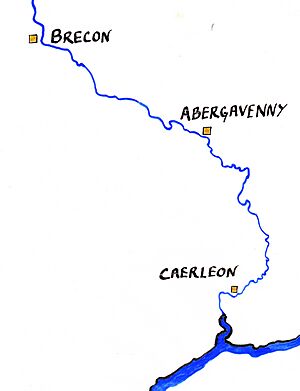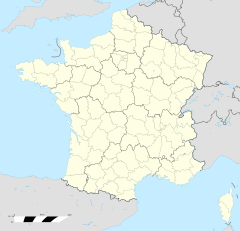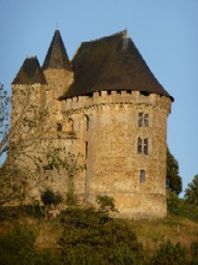Wynebald de Ballon facts for kids
Wynebald de Ballon (born around 1058, died around 1126) was an important Norman nobleman. He came to England when King William II (also known as William Rufus) was ruling. Wynebald arrived with his brother, Hamelin de Ballon, who later became the first Baron of Abergavenny.
Contents
Wynebald's Early Life and Origins
Wynebald was born in France, likely in the old castle of Ballon. This castle was about 12 miles north of Le Mans, the main city of the old region called County of Maine. The castle was so strong it was known as "The Gateway to Maine." Today, Ballon is a French town in the Sarthe area, part of the Pays de la Loire region. Maine was taken over by William, Duke of Normandy (who later became William the Conqueror) in the early 1060s, just before he invaded England.
Wynebald's Role in England

King William II gave Wynebald and his brother Hamelin important jobs. They were asked to secure areas in Wales. Wynebald was given control of the lordship (a large area of land and power) at Caerleon in southern Wales around 1088. His brother Hamelin was put in charge of Abergavenny.
Gifts to Religious Places
Wynebald de Ballon was a generous man. He gave land and other valuable things to several religious places, like abbeys and priories. This was a common way for powerful people to show their faith and support the church during that time.
Gifts to Bermondsey Abbey
Bermondsey Abbey was a monastery founded in 1082 in London. It was a special type of monastery called Cluniac, which was very popular with the Norman kings. King William II himself gave the abbey land for its site.
In 1092, Wynebald de Ballon gave several pieces of land to Bermondsey Abbey. This was probably to please King William II. Some of these gifts included:
- Part of the manor of Upton, which was then in Berkshire and is now in Oxfordshire.
- Part of Hardwick, Buckinghamshire, including a church and some farmland.
- Land in Weedon, which was next to Hardwick.
- The manor of Bridesthorne in Buckinghamshire.
- Tithes (a portion of income or produce) from Eastington in Gloucestershire.
Gifts to Montacute Priory
Montacute Priory in Somerset was another Cluniac monastery. Wynebald also gave gifts to this priory. King Henry I (who ruled from 1100 to 1135) later confirmed these gifts. Wynebald gave the priory a mill in Cadebiri (likely Wilford Mill in North Cadbury) and the church of Karion.
Gifts to St Vincent's Abbey, Le Mans
St Vincent's Abbey was a Benedictine monastery located near Le Mans in France. Wynebald gave this abbey several churches and tithes from lands in England. These included the churches of Tortworth and Aust in Gloucestershire, along with tithes from Gotherington and Bishops Cleeve in Gloucestershire, and Pidecombe in Somerset. His brother Hamelin also made gifts to this abbey.
Gifts to Gloucester Abbey
In 1126, Wynebald made a gift to St Peter's Abbey, Gloucester. This gift included his lordship of Rodeford, his mill at Fromelade, and some land at Ameneye (likely Ampney Crucis, Gloucestershire). King Henry I later confirmed another gift related to this abbey. This was the right to appoint the priest for the church of Inglishcombe in Somerset, given by Hawise de Gurnay, who was Wynebald's daughter-in-law.
His Knights and Their Gifts
Wynebald de Ballon had knights who served him. The names of two of his knights are known because they also made gifts to Bermondsey Abbey in 1092. Odo de Tirone gave the right to appoint the priest for the church and tithes of Ampney Crucis in Gloucestershire. Ansger Brito gave the manor of Preston, which was near Yeovil in Somerset.
Lands Wynebald Owned
Most of the land Wynebald owned had previously belonged to a knight named Turstin FitzRolf. Turstin was important because he carried William the Conqueror's flag during the Battle of Hastings. William the Conqueror rewarded Turstin with many valuable lands in England. It's not fully clear how these lands passed from Turstin to Wynebald. Some historians think Turstin might have been banished by King William Rufus, losing his lands, which then went to Wynebald.
North Cadbury Manor
In 1086, a very old record called the Domesday Book shows that North Cadbury manor in Somerset was held by Turstin fitzRolf. But by 1092, Wynebald was recorded as holding it. This manor seems to have been Wynebald's main home. Later, it passed to his daughter Mabilia and her husband, Henry de Newmarch.
Dyrham Manor
The manor of Dyrham in Gloucestershire also passed from Wynebald de Ballon to the Newmarch family.
Family and Legacy
Wynebald was married to a woman named Elizabeth. They had two sons, Roger and Milo, and one daughter, Mabilia. Roger, the older son, died around 1126. Before he died, he confirmed his father's gift to Gloucester Abbey. Roger had married Hawise de Gournay, and they had three sons: Roger, Hamelin, and Arnold. However, all three of Wynebald's grandsons died without having children of their own before 1166. Because of this, Wynebald's daughter, Mabilia, became the only heir to his lands. She also confirmed her father's gift to Bermondsey Abbey.
Wynebald's lands and estates were passed down to his son-in-law, Henry of Newmarch, through his daughter Mabilia.
Sources
- Sanders, I. J. English Baronies: A Study of their Origin and Descent, 1086–1327, 1960.
- Cokayne, G.E. Complete Peerage



